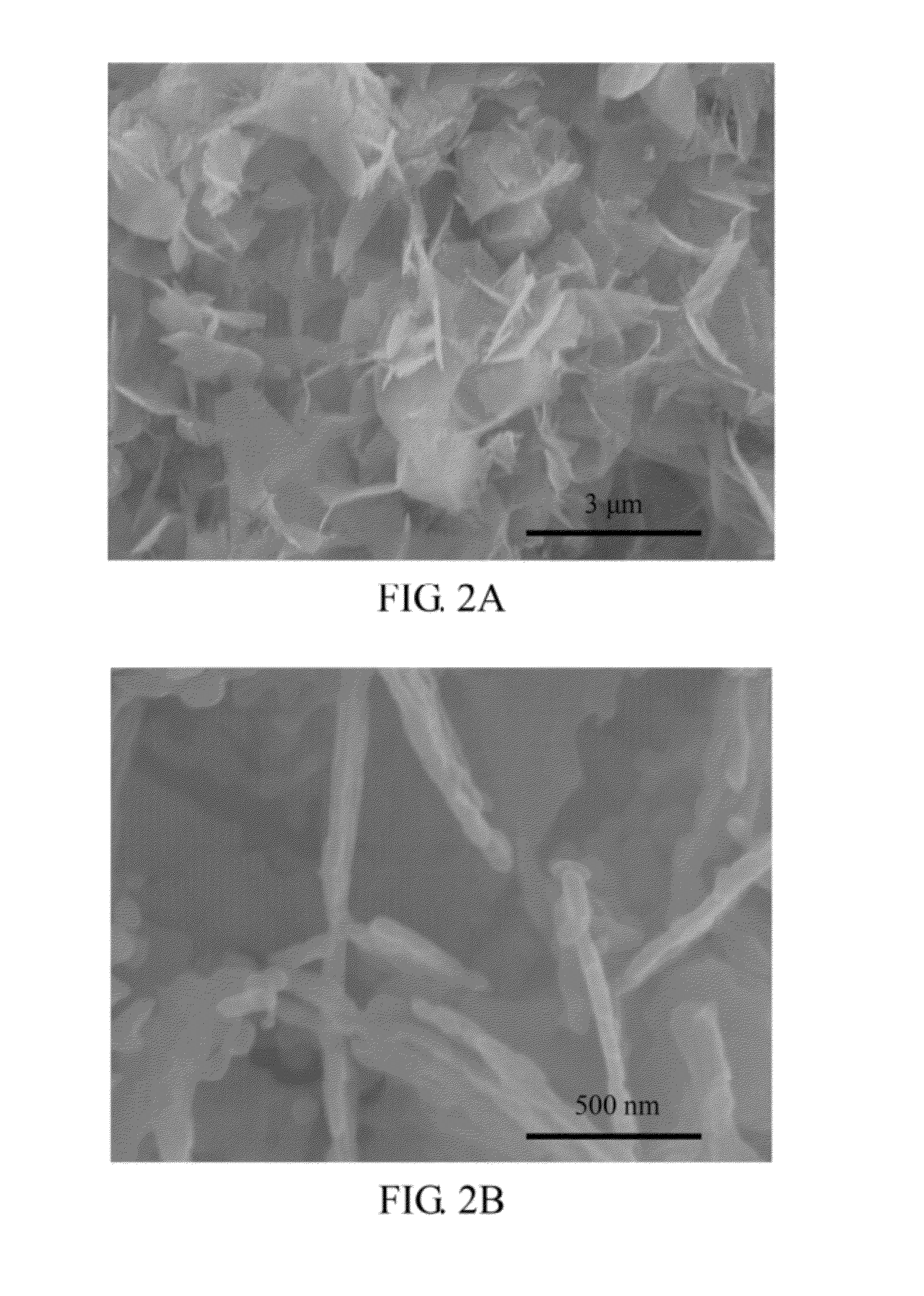LiFePO4 FLAKES FOR Li-ION BATTERY AND METHOD FOR MANUFACTURING THE SAME
a technology of lifepo4 and li-ion batteries, which is applied in the direction of batteries, cell components, electrochemical generators, etc., can solve the problems of insufficient conductivity of lifepo4 flakes, the spinal structure of limn/sub>2/sub>osub>4 /sub>may collapse, and the cycle performance of the battery may further degrade, so as to achieve the effect of increasing the charge/discharge efficiency of the li-
- Summary
- Abstract
- Description
- Claims
- Application Information
AI Technical Summary
Benefits of technology
Problems solved by technology
Method used
Image
Examples
embodiment 1
[0039]The precursors of H3PO4, FeC2O4, and LiOH were mixed in a ratio of 1:1:1, and dissolved in DEG (300 ml) to obtain a mixed organic solution (0.15 M). Next, the mixed organic solution was reacted by reflux at 200° C., under an atmosphere of N2—H2 mixture for 18 hrs. After the mixed organic solution was filtrated, preliminary products were obtained. Then, the preliminary products were heat-treated at 500° C., under an atmosphere of N2 gas for 2 hrs to obtain LiFePO4 flakes of the present embodiment.
[0040]The preliminary products before heat-treatment of the present embodiment were examined by an X-ray diffractometer (Shimadzu 6000) to obtain the crystal structure thereof. The X-ray diffraction pattern was obtained by applying Cu Kα radiation, the 2θ-scanning angle is 15°-45°, and the scanning rate is 1° / min. The obtained XRD diffraction patterns are shown in FIGS. 1A and 1B, wherein FIG. 1A is an XRD diffraction pattern of preliminary products before heat-treatment, and FIG. 1B i...
embodiment 2
[0046]The precursors of H3PO4, FeSO4, and Li2CO3 (1:1:1) and urea with the same molar amount were dissolved in DEG (300 ml) to obtain a mixed organic solution (0.3 M). Next, the mixed organic solution was reacted by reflux at 200° C., under an atmosphere of N2—H2 mixture for 14 hrs. After the mixed organic solution was filtrated, preliminary products were obtained. Then, the preliminary products were heat-treated at 500° C., under an atmosphere of N2 gas for 10 hrs to obtain LiFePO4 flakes of the present embodiment.
[0047]The LiFePO4 flakes of the present embodiment were examined with an X-ray diffractometer, a scanning electron microscope, and a transmission electron microscope by the same methods as disclosed in Embodiment 1. The result of the X-ray diffraction shows that the LiFePO4 flakes of the present embodiment have olivine structures. The result of SEM shows that the LiFePO4 flakes of the present embodiment have flat shapes, the width of each flake is 1-1.5 μm, the thickness ...
embodiment 3
[0049]The precursors of H3PO4, FeC2O4, and LiOH were mixed with a ratio of 1:1:1, and dissolved in DEG (300 ml) to obtain a mixed organic solution (0.15 M). Next, SDS was added into the mixed organic solution, and the mixed organic solution was reacted by reflux at 200° C., under an atmosphere of N2 gas for 10 hrs. After the mixed organic solution was filtrated, preliminary products were obtained. Then, the preliminary products were heat-treated at 500° C., under an atmosphere of N2 gas for 4 hrs to obtain LiFePO4 flakes of the present embodiment.
[0050]The shapes of the LiFePO4 flakes of the present embodiment were observed with a scanning electron microscope (SEM). As shown in FIG. 4, the LiFePO4 flakes have flat shapes (also named as petal-like shape) and bundle like a rose, and the thickness of each flake is thin and uniform, when the LiFePO4 flakes were observed at the magnification of 100000×. In addition, the SEM result also shows that the dispersion of the LiFePO4 flakes of t...
PUM
| Property | Measurement | Unit |
|---|---|---|
| thickness | aaaaa | aaaaa |
| shapes | aaaaa | aaaaa |
| angle | aaaaa | aaaaa |
Abstract
Description
Claims
Application Information
 Login to View More
Login to View More - R&D
- Intellectual Property
- Life Sciences
- Materials
- Tech Scout
- Unparalleled Data Quality
- Higher Quality Content
- 60% Fewer Hallucinations
Browse by: Latest US Patents, China's latest patents, Technical Efficacy Thesaurus, Application Domain, Technology Topic, Popular Technical Reports.
© 2025 PatSnap. All rights reserved.Legal|Privacy policy|Modern Slavery Act Transparency Statement|Sitemap|About US| Contact US: help@patsnap.com



